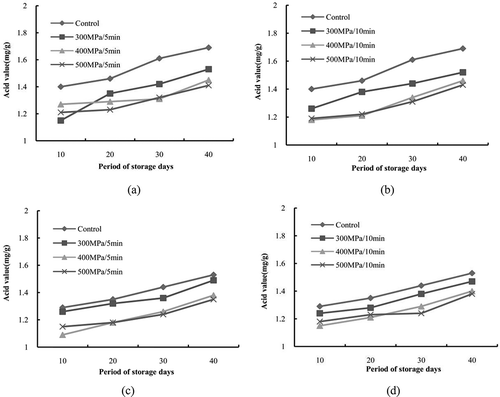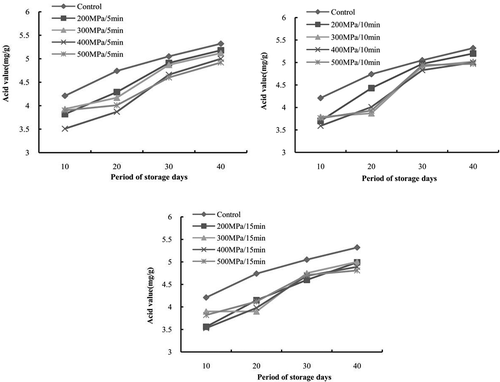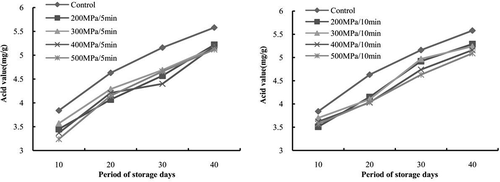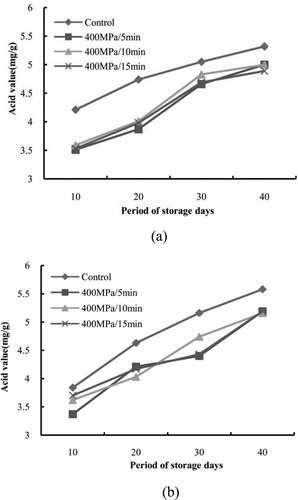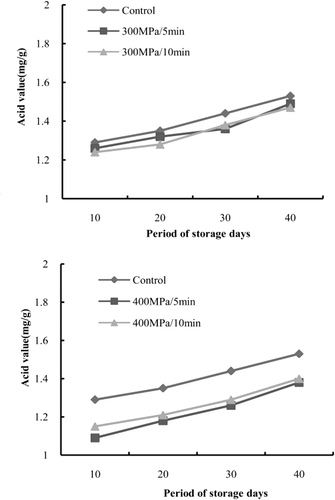ABSTRACT
The mutual effects between food components and packaging materials under high-pressure processing was investigated. Pouches made of Polyethylene terephthalate/Polyethylene and Polyamide/Polyethylene packaging olive oil and glycerol trioleate were subjected to different pressures and holding times, and then stored at 23 ± 2oC for 40 days. The results proved that there were significant effect between lipid and packaging under high-pressure processing treatment. High pressure would be beneficial to extend food shelf life and affect the enthalpy of fusion of packaging materials, especially when making contact with olive oil which probably acted as a plasticizer to change the polymer structure.
Introduction
With the increasing demand for safer and better food, non-thermal sterilization treatments have been rapidly developing. Non-thermal sterilization not only ensures the safety and health of food, but also improves food quality in some aspects, such as natural flavor and fresh appearance.[Citation1–Citation3] As one of the new non-thermal methods, high pressure processing (HPP) has been used recently in reducing enzymatic activity, improving flavor, texture, and shelf life.[Citation4,Citation5] Exposure to different processing conditions may lead to the changes in the properties of the packaging materials, which may influence the quality of the packaged food. Studies have been done to determine the influence of HPP on package materials.[Citation6–Citation9] Dobiás et al.[Citation10] found that HPP affects the functional properties of packaging material, such as loss of sealability and changes in migration levels. Galotto et al.[Citation7] studied the effect of HPP on the mechanical and thermal properties of four complex packaging materials (Polyethylene terephthalate metalized /Polyethylene [PETmet/PE]; Polyethylene/Ethylene vinyl alcohol copolymer/Polyethylene [PE/EVOH/PE]; Polyethylene terephthalate/Polyethylene [PET/PE]; Polylactidesilicon oxide/Polylactide [PPSiOx]) at 400 MPa for 30 min, at temperatures of 20 or 60oC. PPSiOx underwent significant modifications as SiOx completely broke down. Only PE/EVOH/PE, when in contact with water as a simulant, presented a decrease in the melting point temperature. Yoo et al.[Citation11] studied the effect of HPP on LDPE and the packaging material were filled with alcohol as a food simulant and placed for 7 days at 25oC. The results showed that HPP affects the mechanical stregth of packaging material. The oxygen transmission rate was significantly affected due to the improvement of the crystallinity. Moreover, the 95% alcohol was adsorbed to the gap of the film, which results in even better barrier properties than the non-treated material. Galotto et al.[Citation12] investigated the effect of HPP on the mechanical, thermal, and gas barrier properties characteristics of Polylactidesilicon oxide/Polylactide (PLASiOx/PLA) and Polyethylene terephthalate- aluminum oxide (PET-AlOx) films, which in direct contact with Olive oil and distilled water. For the PET-AlOx film, the changes in properties were attributed to the formation of pinholes and cracks during the HPP treatment, and the properties changed significantly in the presence of oil as the food simulant due to the mutual effects between the oil and PET. This study was to investigate the effect of HPP on the mechanical and barrier properties of packaging materials with different food simulants, in order to analyze the influence mechanism among HPP, packaging, and food.
Materials and methods
Materials
The packaging materials tested during this study were 80 µm thick Polyamide /Polyethylene (PA/PE) and 120 µm thick PET/PE (Zhejiang, China). These materials were used to make pouches filled with olive oil and glycerol trioleate as the food simulants and the heat sealed with negligible headspace.
HPP
HPP was performed with the equipment model supplied by Bao Tou KeFa High Pressure Technology Co., Ltd. China. The samples were placed in the 5 L pilot-scale processing vessel, and subjected to hydrostatic pressure from 200 to 500 MPa at 25oC with distilled water as the pressurizing medium. During processing, each sample was immersed in the pressure transmitting fluid (glycol–water 25:75 mixture). After setting manually the required parameters for HPP, the process is automatically controlled. The samples were stored at 23°C after HPP treatment for 40 days. And every 10 days the fatty foods were removed from the pouches to be tested acid value. And the untreated controls with same food components were stored for the same days and temperature. Meanwhile, the mechanical properties and barrier properties of the cut pouches were determined.
Acid value
In this study, the Automatic Kjeldahl Analyzer was used to show the change of acid values of both olive oil and glycerol trioleate before and after HPP treatment. The equipment used was a UDK152 (VELP, Italy). Samples of 5 ml from each pouch were tested, put into alimentary canal, and mounted in the alimentary canal Automatic Kjeldahl Analyzer. After 5 min, the acid values were determined by the titration method.
Mechanical properties
The tensile strength for each material (treated and control) were measured at 25 ± 2oC with a tensile tester (L100OS, LLOYDINS, Britain). Strips (15 × 2.5 cm) of each packaging material were cut using a die cutter in the machine direction (MD). Analyses were carried out with a 1 kN load cell. The initial grip separation was 10 cm and the crosshead speed used was 50 mm/min. Results are the average of 15 specimens for each treatment. Three replicates of each treatment were evaluated.
Differential scanning calorimetry (DSC)
A model DSC calorimeter (Pyris 1 DSC, PerkinElmer, America) was used to determine the effect of food simulations and storage of different packaging materials (PA/PE and PET/PE) used in the study. The heating and cooling rate for the runs was 10oC/min. The sample weight was about 5 mg at temperatures ranging from 10 to 300oC. Calibration was performed using an indium sample. The samples were taken from pouches that at 300 and 400 MPa for 5 min. The melting temperature (Tm) and heat of fusion (ΔH) were calculated from the DSC thermograms (TA Universal Analysis). The results were the average of four replications.
Water vapor transmission rate (WVTR)
Samples were tested in accordance with TSY-T1 (Labthink, Shandong, China) at 25°C and 90% relative humidity. The Permatran was connected to a desktop computer. The output values were expressed as the steady-state WVTR in (g/[m2/24 h]).
Statistical analysis
The data collected were analyzed using analysis of variance of the control and HPP samples. All results were analyzed against control samples. The data analyses were carried out by the SPSS Win 12.0 software (SPSS Inc., Chicago, IL) to determine significant difference from analysis of model F-values. Differences were considered significant at p < 0.05.
Results and discussion
The changes of olive oil acid value under the different HPP treatments
and shows the acid value of olive oil packaged with PET/PE under HPP. Statistically, there was significant difference on the effect of pressure and period of storage. Acid value was found to increase in all the samples during storage. Samples at 300, 400, and 500 MPa showed increase in K-value during storage. The rate was gradually reduced with increasing pressure so that the olive oil acid value for PET/PE decreased rapidly at 500 MPa. The decline rate of acid value was similar under different pressures at the same period. The bent curves in and indicate the same variation trend for the PET/PE samples, but the average acid values for PA/PE were lower than those for PET/PE due to the diversity nature performance of the packaging materials.
The change of material property under different processing conditions
The changes of tensile strength of the two polymer packing materials under HPP treatments are listed in . The tensile strength increased after high-pressure treatment, which means that the packaging became more rigid and less flexible. For the same holding time, it increased with the increase in pressure. The tensile strength of PET/PE after high-pressure treatment at 300 MPa of 5 min was 33.2 MPa and it varied to 39.7 MPa after being treated at 500 MPa for 5 min. It is obvious that the tensile strengths of the test samples changed with the treatment of HPP. The obtained results suggested that the high pressure was the most influential factor on the tensile strength of packaging materials. On the other hand, there was no significant influence of high pressure on tensile strength of PA/PE and PET/PE films under different holding times. With the extension of storage periods, the decline rates were always found to be between 23 and 35 MPa for PET/PE and between 30 and 40 MPa for PET/PE.
Table 1. The change of tensile strength after different pressure and holding time on PET/PE and PA/PE films.
The initial water vapor permeability decreased after high-pressure treatment, most likely due to the change of volume. Similar studies have confirmed that under pressure the packaging materials will shrink and the volume will decrease considerably. During the storage, the packaging would recover in different degrees due to the difference of compression ratio, so the barrier property 1 changed. In contrast with the controls, HPP does not alter significantly the water vapor permeability of PA/PE and PET/PE (). Similar studies carried out have confirmed that, in general, the barrier properties of plastic packaging structures are not significantly affected by the common high-pressure treatments employed in food processing.[Citation13]
Table 2. Water vapor transmission rates for packaging materials before and after HPP processing.
Changes of glycerol trioleate acid value under the different HPP treatment
The results obtained for the acid value of Glycerol trioleate in PET/PE are displayed in . In general, the acid values for PET/PE were significantly affected by the high-pressure treatments employed compared with the controls. The result is consistent with the change of the acid value of olive oil as mentioned before. The acid value of Glycerol trioleate decreased faster than that of olive oil, which can be explained by the influence of air, water, light, and temperature conditions. The higher the pressure was, the more obvious the change was. The influence was obvious under 500 MPa/5 min (p < 0.05), but that is not significant under 400 MPa/5 min (p > 0.05).
The results obtained from the model for various processing conditions have been plotted in . In general, the acid value of glycerol trioleate in PA/PE was not significantly affected by the high-pressure treatments employed in processing. Under 400 and 500 MPa, the acid value was close to the minimum, which was in agreement with the change of glycerol trioleate in PET/PE. For the control, the changes of the acid value were not significant (p > 0.05).
Changes of acid value under the different holding time conditions
From the results, there was no evident correlation between the changes observed and the different HPP holding times ( and ). The acid value of olive oil and glycerol trioleate did not change regularly after the treatments mainly due to the change of materials. The materials would shrink and the volume would decrease. The change of the food simulant was obvious because of the different conditions of materials after HPP. On the other hand, the volume might be not susceptible to the changes of holding time.
Thermal analysis results for PET/PE
The effect of the food simulants and the HPP treatments on tensile strength is presented in . As seen, HPP induced significant changes in the property. Samples without food simulant appeared to present lower values of tensile strength, which could be as a result of the relaxation of the stresses generated during the manufacturing process.[Citation7] An decrease of 15% of tensile strength occurred for the same packaging material when under 400 MPa. Nevertheless when being packaged with olive oil as a fatty food simulant, different phenomenon could be observed. In this case, there was a 32% increase of tensile strength after HPP processing at 400 Mpa. The thermal analysis results of HPP-treated packaging materials were shown in and . A slight decrease can be detected in thermal properties, melting point™ and enthalpy of fusion (ΔH), after HPP for PA/PE without food simulants. The decrease in the heat of fusion could be the result of the induced crystallization caused by high pressure. When pouches filled with olive oil as a simulant were pressurized for 5 min, for PA/PE structures, there was a slight decrease in ΔH associated with the PA at 300 MPa and a decrease in the associated enthalpy of fusion of PA, which could be attributed to a lower crystal size and less crystallinity. However, for PET/PE, there was almost no change in the melting temperature found after HPP treatment. There was a large increase in the heat of fusion and in the degree of crystallinity when contact with oil under 300 MPa/5 min. The enthalpy fusion for the polyethyelene in the PET/PE was affected by the containing food simulant. These changes could be explained by a redistribution in the crystallites size when in contact with oil of a great affinity to the film. The property of PET/PE changed, the pressurized oil was capable of traversing the polyethylene layers and producing plastification and the interaction of the absorbed by the polymer that could modify its structure.[Citation12] The different ΔH between the 300 and 400 MPa could be explained by the compression heating during HPP.[Citation13–Citation15] During the physical compression, the temperature increased for foods. Among the tested food simulants, oils showed the highest compression heating values about 6 to 8.7°C per 100 MPa. The olive oil would be influenced by the different pressures and had different mutual effect with the packaging materials which may not indicate a certain improvement of their crystalline structure with the increased pressure.
Table 3. Tensile strength (MPa) of analyzed plastic with different food simulants.
Table 4. Thermal analysis results for packaging films subjected to various pressure treatment.
Table 5. Thermal analysis results for packaging films subjected to various pressure treatment.
Conclusions
From the results obtained in this work, it is possible to assert that there were significant effect between lipid and packaging under HPP treatment. First, high pressure would be beneficial to extend food shelf life. With the extension of the holding time, HPP could improve the quality of oil and other food components. With the pressure increasing, the effect was more obvious. Second, the treatments applied in this study were capable of increasing the tensile strength of packaging. With the change of periods, a trend of decline for the tensile strength was observed. Moreover, the coefficient of permeability of PA/PE and PET/PE also reflected a trend of decline. For the PET/PE film the changes were more significant when in contact with olive oil that probably acted as a plasticizer. Under the pressure treatment, the volume of packaging material decreased. Once the pressure was removed, the packaging recovered to different degrees due to the difference in compression ratio, which led to both the barrier property of packaging materials and the quality of the simulant change.
Funding
This research was prepared as part of the project supported by the National Natural Science Foundation of China (Grant No. 31101376, Grant No. 31671909) and supported by “the Fundamental Research Funds for the Central Universities” (JUSRP51406A).
Additional information
Funding
References
- Matser, A.M. Advantages of High Pressure Sterilization on Quality of Food Products. Trends in Food Science and Technology 2004, 15, 79–85.
- Morris, C.; Brody, A.L.; Wicker, L. Non-thermal Food Processing/Preservation Technologies: A Review with Packaging Implications. Packaging Technology and Science 2007, 20, 275–286.
- Xu, S.; Cui, S. The Progress of Aseptic Packaging of Food Cold Sterilization Technology. Packaging Engineering 2010, 31, 113–115.
- Oey, I.; Plancken, I.V.; Loey, A.; Hendrickx, M. Does High Pressure Processing Influence Nutritional Aspects of Plant Based Food Systems. Trends in Food Science and Technology 2008, 19, 300–308.
- Perera, N.; Gamage, T.V.; Wakeling, L.; Gamlath, G.G.S.; Versteeg, C. Color and Texture of Apples High Pressure Processed in Pineapple Juice. Innovative Food Science and Emerging Technologies 2010, 11, 39–46.
- Le-Bail, A.; Hamadami, N.; Bahuaud, S. Effect of High-Pressure Processing on the Mechanical and Barrier Properties of Selected Packagings. Packaging Technology and Science 2006, 19(4), 237–243.
- Galatto, M.J.; Ulloa, P.A.; Hernández, D.; Fernández-Martin, F.; Gavara, R.; Guarda, A. Mechanical and Thermal Behavior of Flexible Food Packaging Polymeric Film Materials Under High Pressure/Temperature Treatments. Packaging Technology and Science 2008, 21, 297–308.
- Galatto, M.J.; Ulloa, P.; Escobar, R.; Guarda, A.; Gavara, R.; Miltz, J. Effect of High-Pressure Food Processing on the Mass Transfer Properties of Selected Packaging Materials. Packaging Technology and Science 2010, 23(5), 253–266.
- Yoo, S.; Holloman, C.; Tomasko, D.; Koelling, K.; Pascall, M.A. Effect of High Pressure Processing on the Thermal and Mechanical Properties of Polyethylene Films Measured by Dynamical Mechanical and Tensile Analyses. Packaging Technology and Science 2014, 27(3), 169–178.
- Dobiás, J.; Voldrich, M.; Marek, M.; Chudáckavá, K. Changes of Properties of Polymer Packaging Films During High Pressure Treatment. Journal of Food Engineering 2004, 61, 545–549.
- Yoo, S.; Lee, J.; Holloman, C.; Pascall, M.A. The Effect of High Pressure Processing on the Morphology of Polyethylene Films Tested by Differential Scanning Calorimetry and X-Ray Diffraction and Its Influence on the Permeability of the Polymer. Journal of Applied Polymer Science 2009, 112, 107–113.
- Galatto, M.J.; Ulloa-Guarda, A.; Gavara, R.; Miltz, J. Effect of High-Pressure Food Processing on the Physical Properties of Synthetic and Biopolymer Films. Journal of Food Science 2009, 74, 304–310.
- Lambert, Y.; Demazeau, G.; Largeteau, A.; Bouvier, J.M.; Laborde-Croubit, S.; Cabannes, M. Packaging for High-Pressure Treatments in the Food Industry. Packaging Technology and Science 2000, 13, 63–71.
- Rasanayagam, V.; Balasubramaniam, V.M.; Ting, E.; Sizer, C.E.; Bush, C.; Anderson, C. Compression Heating of Selected Fatty Food Materials During High-Pressure Processing. Journal of Food Science 2003, 68, 254–259.
- Ting, E.; Balasubramaniam, V.M.; Raghubeer, E. Determining Thermal Effects in High Pressure Processing. Food Technology 2002, 56, 31–35.

